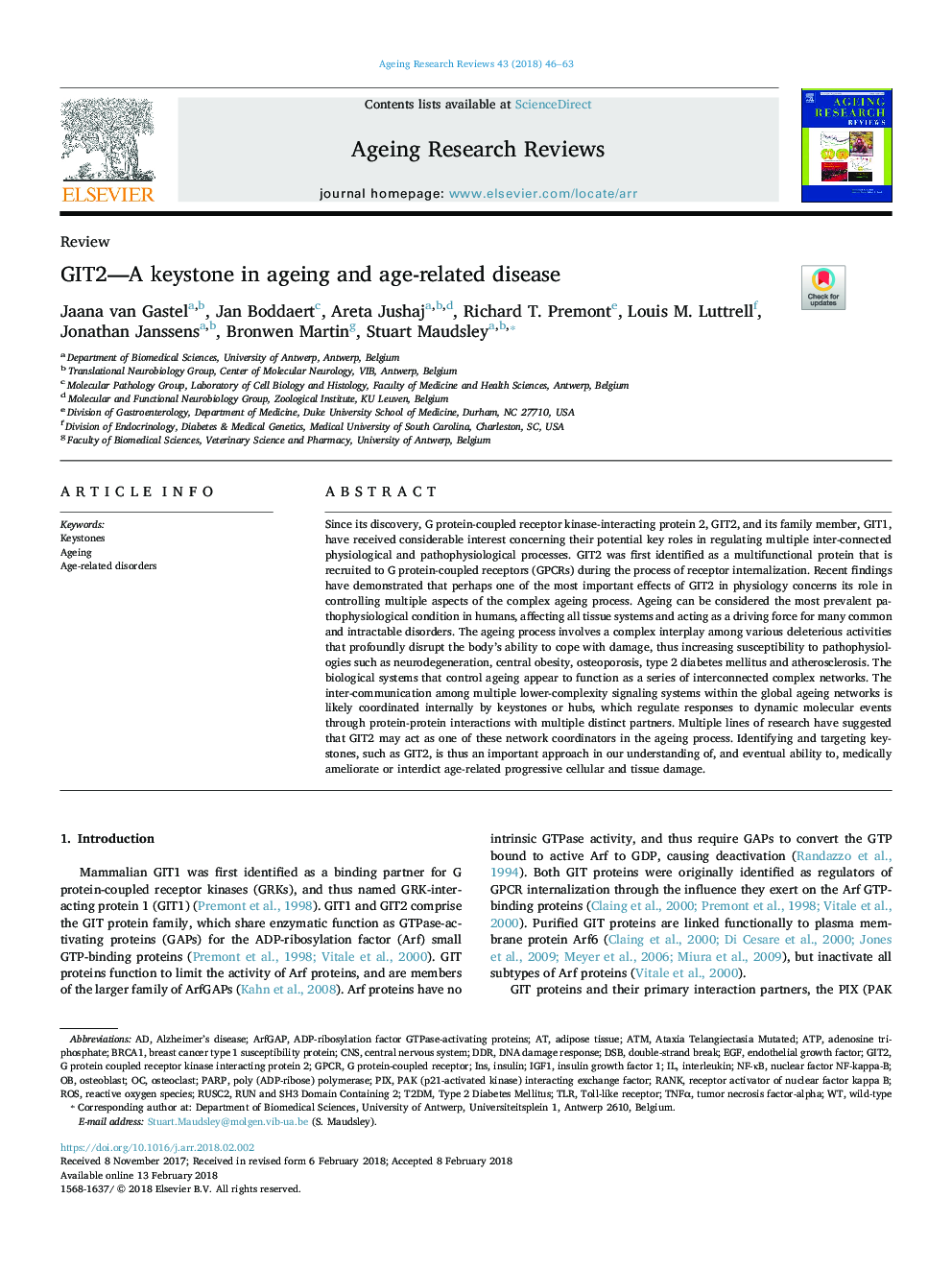| کد مقاله | کد نشریه | سال انتشار | مقاله انگلیسی | نسخه تمام متن |
|---|---|---|---|---|
| 8257178 | 1534290 | 2018 | 18 صفحه PDF | دانلود رایگان |
عنوان انگلیسی مقاله ISI
GIT2-A keystone in ageing and age-related disease
دانلود مقاله + سفارش ترجمه
دانلود مقاله ISI انگلیسی
رایگان برای ایرانیان
کلمات کلیدی
Age-related disordersGPCRTLRPARPDDRT2DMPIXINSGIT2TNFαReceptor activator of nuclear factor kappa BEGFDSBNF-κBArfGAPataxia telangiectasia mutated - Ataxia telangiectasia جهش یافته استIgf1 - IGF1ROS - ROSAdenosine tri-phosphate - آدنوزین تری فسفاتATP - آدنوزین تری فسفات یا ATPOsteoblast - استئوبلاست Osteoclast - استخوانکاه، استئوکلاستinsulin - انسولینinterleukin - اینترلوکینAdipose tissue - بافت چربیAlzheimer’s disease - بیماری آلزایمرtumor necrosis factor-alpha - تومور نکروز عامل آلفاToll-like receptor - تیالآرATM - خودپردازCNS - دستگاه عصبی مرکزیType 2 diabetes mellitus - دیابت نوع دوRank - رتبهAgeing - سالخوردهbreast cancer type 1 susceptibility protein - سرطان پستان نوع 1 حساسیت پروتئینcentral nervous system - سیستم عصبی مرکزیdouble-strand break - شکست دو ردیفInsulin growth factor 1 - عامل رشد انسولین 1Endothelial growth factor - فاکتور رشد اندوتلیالwild-type - نوع وحشیDNA damage response - واکنش به آسیب DNA poly (ADP-ribose) polymerase - پلی (ADP-ribose) پلیمرازBRCA1 - ژن BRCA1Reactive oxygen species - گونههای فعال اکسیژنG protein-coupled receptor - گیرندههای جفتشونده با پروتئین جی
موضوعات مرتبط
علوم زیستی و بیوفناوری
بیوشیمی، ژنتیک و زیست شناسی مولکولی
سالمندی
پیش نمایش صفحه اول مقاله

چکیده انگلیسی
Since its discovery, G protein-coupled receptor kinase-interacting protein 2, GIT2, and its family member, GIT1, have received considerable interest concerning their potential key roles in regulating multiple inter-connected physiological and pathophysiological processes. GIT2 was first identified as a multifunctional protein that is recruited to G protein-coupled receptors (GPCRs) during the process of receptor internalization. Recent findings have demonstrated that perhaps one of the most important effects of GIT2 in physiology concerns its role in controlling multiple aspects of the complex ageing process. Ageing can be considered the most prevalent pathophysiological condition in humans, affecting all tissue systems and acting as a driving force for many common and intractable disorders. The ageing process involves a complex interplay among various deleterious activities that profoundly disrupt the body's ability to cope with damage, thus increasing susceptibility to pathophysiologies such as neurodegeneration, central obesity, osteoporosis, type 2 diabetes mellitus and atherosclerosis. The biological systems that control ageing appear to function as a series of interconnected complex networks. The inter-communication among multiple lower-complexity signaling systems within the global ageing networks is likely coordinated internally by keystones or hubs, which regulate responses to dynamic molecular events through protein-protein interactions with multiple distinct partners. Multiple lines of research have suggested that GIT2 may act as one of these network coordinators in the ageing process. Identifying and targeting keystones, such as GIT2, is thus an important approach in our understanding of, and eventual ability to, medically ameliorate or interdict age-related progressive cellular and tissue damage.
ناشر
Database: Elsevier - ScienceDirect (ساینس دایرکت)
Journal: Ageing Research Reviews - Volume 43, May 2018, Pages 46-63
Journal: Ageing Research Reviews - Volume 43, May 2018, Pages 46-63
نویسندگان
Jaana van Gastel, Jan Boddaert, Areta Jushaj, Richard T. Premont, Louis M. Luttrell, Jonathan Janssens, Bronwen Martin, Stuart Maudsley,